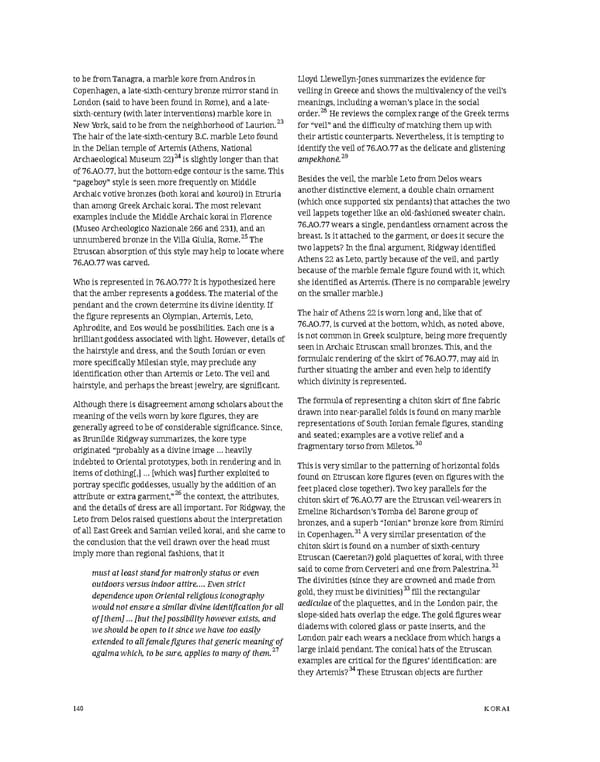to be from Tanagra, a marble kore from Andros in Lloyd Llewellyn-Jones summarizes the evidence for Copenhagen, a late-sixth-century bronze mirror stand in veiling in Greece and shows the multivalency of the veil’s London (said to have been found in Rome), and a late- meanings, including a woman’s place in the social sixth-century (with later interventions) marble kore in order.28 He reviews the complex range of the Greek terms New York, said to be from the neighborhood of Laurion.23 for “veil” and the difficulty of matching them up with The hair of the late-sixth-century B.C. marble Leto found their artistic counterparts. Nevertheless, it is tempting to in the Delian temple of Artemis (Athens, National identify the veil of 76.AO.77 as the delicate and glistening Archaeological Museum 22)24is slightly longer than that ampekhonē.29 of 76.AO.77, but the bottom-edge contour is the same. This “pageboy” style is seen more frequently on Middle Besides the veil, the marble Leto from Delos wears Archaic votive bronzes (both korai and kouroi) in Etruria another distinctive element, a double chain ornament than among Greek Archaic korai. The most relevant (which once supported six pendants) that attaches the two examples include the Middle Archaic korai in Florence veil lappets together like an old-fashioned sweater chain. (Museo Archeologico Nazionale 266 and 231), and an 76.AO.77 wears a single, pendantless ornament across the unnumbered bronze in the Villa Giulia, Rome.25 The breast. Is it attached to the garment, or does it secure the Etruscan absorption of this style may help to locate where two lappets? In the final argument, Ridgway identified 76.AO.77 was carved. Athens 22 as Leto, partly because of the veil, and partly because of the marble female figure found with it, which Who is represented in 76.AO.77? It is hypothesized here she identified as Artemis. (There is no comparable jewelry that the amber represents a goddess. The material of the on the smaller marble.) pendant and the crown determine its divine identity. If the figure represents an Olympian, Artemis, Leto, The hair of Athens 22 is worn long and, like that of Aphrodite, and Eos would be possibilities. Each one is a 76.AO.77, is curved at the bottom, which, as noted above, brilliant goddess associated with light. However, details of is not common in Greek sculpture, being more frequently the hairstyle and dress, and the South Ionian or even seen in Archaic Etruscan small bronzes. This, and the more specifically Milesian style, may preclude any formulaic rendering of the skirt of 76.AO.77, may aid in identification other than Artemis or Leto. The veil and further situating the amber and even help to identify hairstyle, and perhaps the breast jewelry, are significant. which divinity is represented. Although there is disagreement among scholars about the The formula of representing a chiton skirt of fine fabric meaning of the veils worn by kore figures, they are drawn into near-parallel folds is found on many marble generally agreed to be of considerable significance. Since, representations of South Ionian female figures, standing as Brunilde Ridgway summarizes, the kore type and seated; examples are a votive relief and a fragmentary torso from Miletos.30 originated “probably as a divine image … heavily indebted to Oriental prototypes, both in rendering and in This is very similar to the patterning of horizontal folds items of clothing[,] … [which was] further exploited to found on Etruscan kore figures (even on figures with the portray specific goddesses, usually by the addition of an feet placed close together). Two key parallels for the attribute or extra garment,”26 the context, the attributes, chiton skirt of 76.AO.77 are the Etruscan veil-wearers in and the details of dress are all important. For Ridgway, the Emeline Richardson’s Tomba del Barone group of Leto from Delos raised questions about the interpretation bronzes, and a superb “Ionian” bronze kore from Rimini of all East Greek and Samian veiled korai, and she came to in Copenhagen.31 A very similar presentation of the the conclusion that the veil drawn over the head must chiton skirt is found on a number of sixth-century imply more than regional fashions, that it Etruscan (Caeretan?) gold plaquettes of korai, with three said to come from Cerveteri and one from Palestrina.32 must at least stand for matronly status or even outdoors versus indoor attire.… Even strict The divinities (since they are crowned and made from gold, they must be divinities)33 fill the rectangular dependence upon Oriental religious iconography would not ensure a similar divine identification for all aediculae of the plaquettes, and in the London pair, the of [them] … [but the] possibility however exists, and slope-sided hats overlap the edge. The gold figures wear we should be open to it since we have too easily diadems with colored glass or paste inserts, and the extended to all female figures that generic meaning of London pair each wears a necklace from which hangs a agalma which, to be sure, applies to many of them.27 large inlaid pendant. The conical hats of the Etruscan examples are critical for the figures’ identification: are they Artemis?34 These Etruscan objects are further 140 KORAI
 Ancient Carved Ambers in the J. Paul Getty Museum Page 149 Page 151
Ancient Carved Ambers in the J. Paul Getty Museum Page 149 Page 151